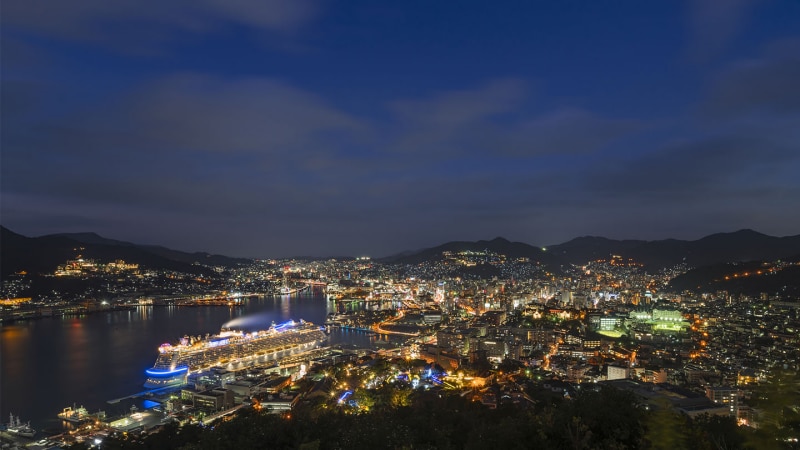Guide to cruising to Japan

Quick insights
- Cruises to Japan can offer travelers a mix of vibrant cities, ancient temples and historical sites.
- Peak cherry blossom season, which runs late March to early April, is Japan’s busiest tourist season.
- Several major cruise lines offer cruises that sail from the U.S. to Japan.
Japan is an island nation off the eastern coast of China with more than 6,000 islands and 18,000 miles of coastline. If you're looking to explore this vibrant country by land and sea, a Japan cruise may be just the ticket. Read on to learn more about some of the ins and outs of cruising to Japan.
Introduction to Japan cruises
Japan may appeal to travelers as an exciting cruise destination. This Pacific Island country has a rich mix of culture, history and natural beauty. Cruising can allow travelers to see many parts of Japan during a single trip, including historic temples as well as the hustle and bustle of downtown Tokyo.
Whether you’re looking for a luxury liner or a more budget friendly cruise ship, you have options when setting sail to the “Land of the Rising Sun.” There are many well-known cruise lines with trips that sail around Japan, some which also stop in Korea or offer epic multi-week routes that spans the Pacific Ocean.
The best month for a Japan cruise
Japan has four distinct seasons. Depending on where and when you go, you can experience hot, humid summers or cold, snowy winters.
One of the most popular times to visit Japan is during its peak cherry blossom season which runs from late March to early April. Travelers may also want to consider cruising in autumn to enjoy Japan’s fall foliage and moderate temps.
The off-peak season is during late autumn and winter, so you may experience fewer crowds if you cruise then. Summer and early autumn are typhoon season, so weather could impact your travel during this season.
Cruising from the U.S. to Japan
You can board a ship in the U.S. and sail across the Pacific Ocean to Japan. With a considerable distance to cover, these cruises are generally more than two weeks long, with at least 4 consecutive days spent at sea crossing the Pacific.
These cruises sail from a few ports in the U.S. as well as Canada—typically Los Angeles, Seattle, Alaska and Vancouver. You can choose to book a roundtrip cruise or arrange a flight home from the final stop of your cruise.
A Japan cruise itinerary
Cruising through Japan can give you a taste of the flavor, customs and history of this country. Japan offers a variety of sights, from bright neon skylines teeming with skyscrapers to peaceful Zen gardens and ancient temples. Some cruises may even take you to the subtropical coastlines of Okinawa that have serene beaches and coral reefs.
Japan cruises often last at least 8 days and stop in many ports throughout the country. Common sights in a Japanese cruise itinerary include stops and excursions to Hiroshima and Nagasaki, Mt. Fuji and Tokyo.
There are also plenty of popular cruise lines that offer cruises that sail through Japan as well as to other ports in Asia, like Vietnam, Hong Kong and Taiwan.
Preparing for your Japan cruise
When preparing to go to on a cruise to Japan, it can be helpful to think through what documents you need to bring and what to pack:
Essential documents
You will need to bring a passport on a cruise to Japan, even if your cruise begins and ends in the U.S. You may want to check with your cruise line and destination country to confirm the required documents.
Packing
When packing for Japan, you may want to take the weather, planned excursions and cruise events into account. Depending on the time of year you’re cruising and where you’re going, you may experience snowy conditions or hot and humid weather.
You may also want to consider bringing a carry-on bag with you. It is not uncommon to arrive at your room on the ship before your luggage, so having a bag with essentials and important documents can provide a smoother transition onto the boat.
What to know before cruising to Japan
When it comes to being on the ship, here are a few other things you may want to know:
- Speaking English: English is widely spoke on Japan cruises. At ports, you may find plenty of English speakers as well.
- Health: Seasickness is common on cruises. If you’re prone to motion sickness, consider bringing over the counter medication to help avoid seasickness. Cruise ships typically have medical staff on board as well.
- Tipping: Most cruise lines add a daily service charge or gratuity to the price of the trip. Many services aboard a ship, like spa and bar service, automatically add a gratuity to your bill, so tipping may not be necessary.
- Wi-Fi: Wi-Fi likely will be an additional charge. Most cruise lines charge a daily fee for access to Wi-Fi. Also, keep in mind that cruise ship internet likely won’t be as fast and reliable as your home internet connection.
Before traveling to any foreign country, it may be wise to check with the U.S. State Department. It can sometimes issue travel advisories for increased caution in certain areas.
In summary
Cruising to Japan can be an eye-opening and unique experience. Travelers may get the opportunity to see bustling metropolises and peaceful Zen gardens, all while experiencing the food and culture of Japan.
With a variety of seasons, climates and geography to explore, people cruising to or around Japan have plenty of options. And for those looking for an extended experience, there are many cruise lines that offer multi-week trips that sail across the Pacific from the U.S. or travel in and around various ports in and around Southeast Asia.



